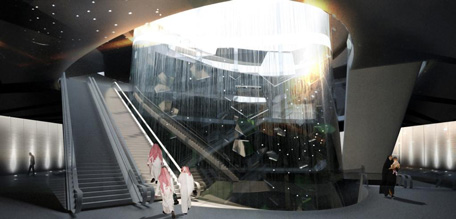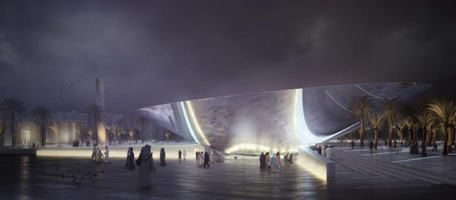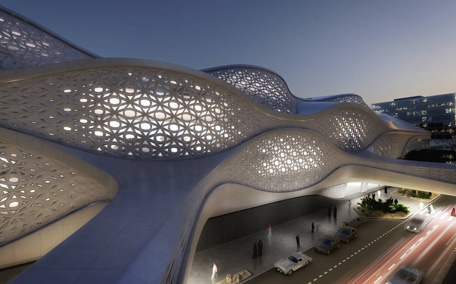- City Fajr Shuruq Duhr Asr Magrib Isha
- Dubai 04:20 05:42 12:28 15:53 19:08 20:30

GERBER OLAYA METRO Interior compressed
The Arriyadh Development Authority (ADA) has selected the winning designs for Riyadh Metro’s three main stations.
These iconic stations will transform Riyadh streets as they become the most visible elements of the city’s new world-class public transport system. By providing tranquil oases for travel, shopping and dining, these stations will place Riyadh Metro at the heart of city life.
-compressed.jpg) GERBER OLAYA METRO Exterior (East-entrance) compressed
GERBER OLAYA METRO Exterior (East-entrance) compressed
Riyadh Metro is the vision of Custodian of the Two Holy Mosques and King of Saudi Arabia, King Abdullah bin Abdulaziz Al Saud. It is being developed by the ADA, the government body responsible for the planning and development of Riyadh.
 SNOHETTA DOWN TOWN METRO mid level compressed
SNOHETTA DOWN TOWN METRO mid level compressed
The ADA was selected for its experience of delivering a number of award-winning projects around the city, including the Diplomatic Quarter, which houses most of the Riyadh-based embassies, the world acclaimed Wadi Hanifah regeneration project, as well as a historic village of Atturaif, a Unesco World Heritage site.
The winning designs and architecture consultancies are:
• Gerber Architekten from Germany for Olaya Metro Station
• Snohetta from Norway for Downtown Metro Station (Qasr Al Hokm)
• Zaha Hadid from the United Kingdom for King Abdullah Financial District Metro Station
In a media statement, the authority said that the winning designs were selected for their outstanding conceptual thinking and powerful design. “Each of the stations creates a modern landmark for the city, as well as supporting the technical requirements of Riyadh Metro.”
 SNOHETTEA DOWNTOWN METRO concept compressed
SNOHETTEA DOWNTOWN METRO concept compressed
The Riyadh Public Transportation network is the world’s largest urban transport project in development. It includes six underground, elevated and at-grade metro lines, three ‘bus rapid transit’ lines, a circular city-centre bus route and community bus services. Park and ride facilities will serve many of the stations around the city. In total, Riyadh Metro will have 85 stations, plus over 500 stops on the bus network.
 ZAHA HADID KAFD METRO Exterior compressed
ZAHA HADID KAFD METRO Exterior compressed
Khalid Hazzani, Director at the Arriyadh Development Authority, said: “The selection of station designs is an exciting milestone for Riyadh Metro. These iconic landmarks will transform the city streetscape. They will not only provide elegant interchanges for one of the most advanced public transport systems in the world, but also provide new public spaces for shopping, eating and working.
“Riyadh Metro is benefitting from world-leading design expertise, ensuring Riyadh remains at the forefront of sustainable urban design.”
The Winning Entries:
• Olaya Metro Station
The ADA appointed Gerber Architekten from Germany to design Riyadh Metro’s main station at the intersection of Metro Lines 1 and 2. The station will be located between Olaya Street and King Fahad Road, close to the Kingdom Tower and King Abdullah Road.
The station design creates a new public plaza integrated within an iconic city-centre development. Inside the station, a large, open entrance hall allows visitors to see across all four storeys of the building, including the two metro lines, a mezzanine level with shops and food halls, and an open concourse housing the ticket barriers.
• Downtown Main Station (Qasr Al Hokm)
Snohetta from Norway has been appointed to design the main Downtown station at the intersection of Al Madinah Al Munnawarah Street and King Faisal Street, in the Al Doho quarter. The station will serve as a transfer point between Metro Lines 1 and 3, as well as integrating with the bus network, like all the main stations.
The Downtown station design is a model of sustainable development, with a large canopy creating a shaded plaza and allowing natural light to filter to the underground concourse. The station also respectfully houses Eid Mosque at the south-west corner.
• KAFD Main Station
Zaha Hadid from the United Kingdom has been appointed to design the main station at King Abdullah Financial District (KAFD), at the intersection of Metro Lines 4 and 6. The station is situated at the eastern edge of the district, close to the Northern Ring Road and just west of King Fahad Road.
Inside and out, the design replicates soft, fluid wave forms, creating an impressive aesthetic whilst also minimising solar gain [heat transfer]. Geometric latticework covers the building facade, creating a modern twist on the Mashrabiya found in traditional Arabic architecture.
About Riyadh Metro
Riyadh Metro is the largest public transport system in development across the globe, combining a city-wide metro, rapid transit bus, and park and ride services.
This world-class public transport system will provide the people of Riyadh with a comfortable, reliable and fast way to travel around the city. By providing a compelling and sustainable alternative to car travel, Riyadh Metro will help to reduce traffic congestion and improve air quality in the city. It is designed to provide the highest quality passenger experience, through iconic station design, air-conditioned waiting environments, and real-time travel information.
The ADA is creating a world-class public transport infrastructure that can support Riyadh’s rapid growth, as the city’s population is projected to rise 40 per cent by 2030, and daily travel demand set to increase by 60 per cent.
The Metro service
Riyadh’s metro service has six lines with underground, elevated and at-grade sections. The completed system will have 85 air-conditioned stations, with transfer points where the lines intersect:
• Blue line: Olaya Street – Batha Street – Al Hayer Road (39km)
• Green Line: King Abdullah Road (25km)
• Red Line: Madina Al Munawra – Amir Saad bin Abdul – Rahman Al Awal Road (40km)
• Orange Line: To King Khaled International Airport (30km)
• Yellow Line: King Abdul Aziz Road (13km)
• Purple Line: Abdul Rahman bin Ouf Street – Shaikh Hassan bin Hussain bin Ali Street (30km)
The Bus service
The public transport system will also include an expansive bus network, with over 500 suburban and city-centre stops:
• Three-line Bus Rapid Transport (BRT) network connecting major suburbs to the centre (85km)
• Two circular lines around the city centre (83km)
• 18-line community bus service (405km) for local journeys and transit to BRT and Metro stations.
ALSO READ:
Which were the three costliest apartments in Dubai?

1.5 kg tumour removed from woman’s face
![]() Follow Emirates 24|7 on Google News.
Follow Emirates 24|7 on Google News.